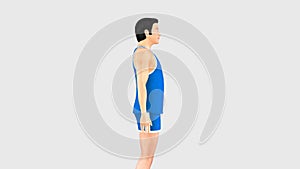- Stock Photography: ANGULAR MOVEMENT OF SHOULDER JOINT by 7activestudio
- Price: 1$
- Size Facebook: 1702 x 630 px
- Size Twitter: 1500 x 500 px
- Size LinkedIn: 1128 x 191 px
More Facebook, Twitter and LinkedIn Cover Photos
Cover photo info
- Photo title: Angular Movement of Shoulder Joint
- Author: 7activestudio
- Cover photo description:
- Shoulder joint is attached to axial skeleton via the clavicle at SC joint • Scapula movement usually occurs with movement of humerus – Humeral flexion & abduction require scapula elevation, rotation upward, & abduction – Humeral adduction & extension results in scapula depression, rotation downward, & adduction – Scapula abduction occurs with humeral internal rotation & horizontal adduction – Scapula adduction occurs with humeral external rotation & horizontal abduction • Wide range of motion of the shoulder joint in many different planes requires a significant amount of laxity • Common to have instability problems – Rotator cuff impingement – Subluxations & dislocations • The price of mobility is reduced stability • The more mobile a joint is, the less stable it is & the more stable it is, the less mobile • Scapula, clavicle, & humerus serve as attachments for shoulder joint muscles – Scapular landmarks • supraspinatus fossa • infraspinatus fossa • subscapular fossa • spine of the scapula • glenoid cavity • coracoid process • acromion process • inferior angle Scapula, clavicle, & humerus serve as attachments for shoulder joint muscles – Humeral landmarks • Head • Greater tubercle • Lesser tubercle • Intertubercular groove • Deltoid tuberosity Key bony landmarks – Acromion process – Glenoid fossa – Lateral border – Inferior angle – Medial border – Superior angle – Spine of the scapula
- Image ID:50061433
- Views:594
- Downloads:0
Keywords for Facebook, Twitter and LinkedIn timeline photos
abduction
adduction
anatomical
arm
axial
axillary
ball
blade
bone
bones
bony
bursa
bursae
capsule
cavity
clavicle
coracoid
culf
deltoid
elbow
fingers
flexion
fossa
glenohumeral
glenoid
human
humerial
humerus
inferior
joint
joints
membrane
mobility
multiaxial
muscle
nerves
radius
scapula
shoulder
skeleton
socket
subcoracoid
subdeltoid
synovial
ulna
upper
wrist














